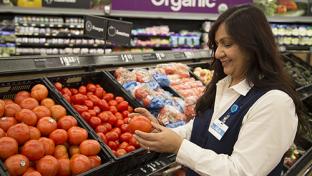2019 Retailer of the Year: Walmart Is Reshaping Grocery From the Ground Up

What’s the one thing consumers can’t buy?
Time.
“Or is it?” Doug McMillon, president and CEO of Walmart Inc., wondered in his message to stockholders this past June.
Certainly, most of the innovations that retailers have been furiously pursuing can be said to have been designed to save time, enhance convenience or otherwise make it easier for consumers to acquire their basic daily needs.
Among retailers that sell groceries, Walmart has been head and shoulders above the pack in the reinvention of routine buying and selling. It’s one of the reasons that Progressive Grocer selected the Bentonville, Ark.-based mega-merchant as its 2019 Retailer of the Year.
.jpg?itok=kklsEkuT)
And it’s not just about the consumer’s time — it’s about the associate’s time, and finding ways to make their job easier so they can focus more attention on the shopper.
“We’re learning how to work in an agile way,” McMillon said in his June stockholders address, “with customer experiences designed thoughtfully from the start, and with technology doing more of the work so our associates can focus on customers and members.”
One of Walmart’s latest efforts: solving the last mile, or rather, the last few feet of the last mile. The retailer is piloting in-home grocery delivery to nearly 1 million customers in three markets: Kansas City, Pittsburgh, and Vero Beach, Fla. All deliveries are done by associates with at least a year of service. Customers are notified upon arrival and can watch a live first-person view of their delivery, or a recording of it later.
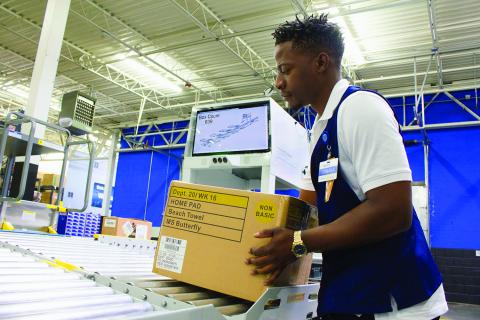
Entering someone’s home when they’re not there — it’s the new frontier of the creep factor.
“We're trying to understand customers’ appetite and whether or not that’s a process they enjoy,” Tom Ward, SVP of digital operations, tells PG during a visit to Walmart’s home office. “We definitely know customers want the convenience, the fact that they can come back and all these groceries are already inside the house. .... They can see the whole process happening. They can see the items get put away into the fridge and the cupboard, and they can see the associate leave again. For the small test that we’ve got right now, people really love this service. It’s something we’re going to continue to experiment with.”
Where Customers Want to Go
Walmart’s experiments in grocery appear to be paying off.
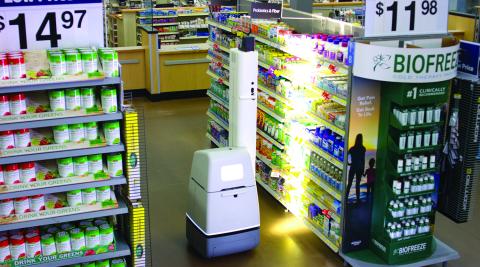
For the second quarter of its 2020 fiscal year, the retailer posted a U.S. ecommerce sales increase of 37%, including strong growth in online grocery, along with a 7.3% rise in U.S. comparable sales on a two-year stacked basis — the mega-retailer’s strongest growth in more than a decade, as reported in August. The segment’s operating income climbed 4%, marking its fifth straight quarter of growth.
Total revenue for the company came to $130.4 billion, a $2.3 billion increase, or 1.8%. Walmart operates more than 11,300 stores under 58 banners in 27 countries, as well as ecommerce websites, employing more than 2.2 million associates worldwide. The company is No. 1 onPG’s 2019 Super 50 list of the top grocers in the United States, with sales topping $514.4 billion.
Why Walmart? The Company in the Headlines
Walmart dominated the business news headlines over the past 12 months. Here’s a few of the stories we reported that influenced our selection of PG’s Retailer of the Year:
Oct. 19, 2018: Walmart Unveils Grocery ‘Distribution Center of the Future’ for 2020
Jan. 15, 2019: Walmart to Debut High-Tech Consolidation Center
Feb. 26. 2019: Walmart Reveals New Plastic Packaging-Waste Reduction Commitments
April 2, 2019: Walmart Voice Order Debuts
April 10, 2019: Walmart Unpacks Reusable Bag Campaign
April 16, 2019: Walmart to Remodel 500 Stores
April 24, 2019: Walmart Entering Beef Industry
May 1, 2019: Walmart, Digimarc Automate Markdown Process for Packaged Fresh Food
May 14, 2019: Walmart Introduces Free NextDay Delivery
June 7, 2019: Walmart to Launch Delivery Inside the Home
June 11, 2019: Walmart Subscribing to 36 Community Solar Gardens
June 17, 2019: Walmart Offers Unlimited Grocery Delivery
July 25, 2019: Walmart Pilots Self-Driving Car
Aug. 19, 2019: Walmart Offering Shoppable Recipes Via Tasty App
At McMillon’s side leading this success is Greg Foran, president and CEO of Walmart U.S. He is responsible for the strategic direction and performance of Walmart’s 4,600 U.S. stores and more than 1 million associates. Since taking the lead 2014, Foran’s team has led a transformation of the U.S. business, executing a strategy around Every Day Low Costs and Every Day Low Price. The result: multiple consecutive quarters of comp sales growth over the past several years. (Since this story was first published, Foran announced his departure from Walmart, to be succeeded by the former head of Sam's Club, John Furner.)
“Customers are responding to the improvements we’re making, the productivity loop is working, and we’re gaining market share,” McMillon said during the August earnings call, when EVP and CFO Brett Briggs observed, “Comp sales growth reflects strength in grocery, including strong growth in private brands. We’ve been pleased with the consistently strong performance in food and consumables.”
Walmart ended Q2 with more than 2,700 grocery pickup locations and more than 1,100 delivery locations, the unveiling of Walmart InHome Delivery, having NextDay delivery service from Walmart.com cover about 75% of the U.S. population, the launch of same-day pickup nationwide at Sam’s Club, a collaboration with other major companies as part of the FDA’s program to evaluate the use of blockchain to protect pharmaceutical product integrity, an agreement with U.S. Solar for 36 community solar gardens, and the completion with Electrify America of 120-plus car-charging stations at Walmart stores across the country, with plans for expansion.
Walmart’s great quarterly performance is no fluke, according to Eli Finkelshteyn, CEO and co-founder of Constructor.io, a San Francisco-based cloud-based search-as-a-service provider, who believes that the mega-retailer’s strong results are due to its successful digital initiatives and solid online grocery options that enable it to beat Seattle-based ecommerce behemoth Amazon at its own game.
Finkelshteyn said of Walmart: “As they continue to focus on the quickly growing online grocery business in Middle America, where their brand is powerful and they have many locations, their strong ecommerce growth will continue.”
To be sure, ecommerce investment is a priority for Walmart. But physical stores are still an integral part of the retailer’s expanding omnichannel experience, from automated pickup towers in stores to back-of-house robotic fulfillment systems.
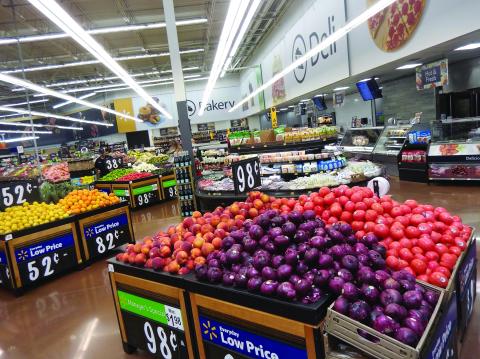
“The No. 1 thing that’s driving it is where customers want to go,” Ward says. “People still come through the doors of the Supercenters and the Neighborhood Markets, and physical traffic’s increasing. But increasingly, people want to shop online and they want the convenience of being able to do that. What that means is different to different people. That’s where you’re seeing us evolve the different propositions, like our huge pickup footprint now, deliveries rolling out really aggressively, all the way through to the super-innovative things like the in-home discussions. Wherever it is that customers want to go, we want them to be able to interact with Walmart.”
And at the heart of it all is grocery.
“Grocery’s obviously super-important to customers, and therefore it’s super-important to Walmart,” Ward asserts. “I think people increasingly look to us to save them money, and more often now save them time as well. One of the biggest time crunches in any busy family’s week is grocery shopping. The easier we can make that, both in-store and online, for customers, the better. That’s where most of the focus on our innovation is being driven from online grocery, for sure.”
The Momentum Continues
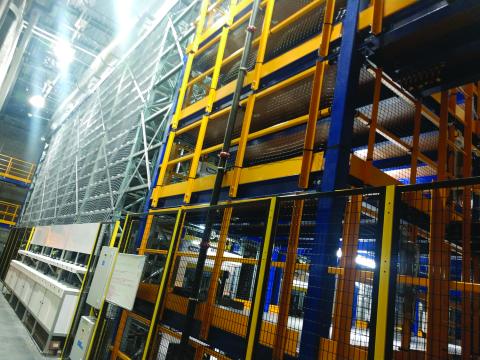
Walmart may be the best positioned of any traditional retailer to not only match but also beat Amazon as the e-tailer continues to burrow its way into the grocery space with its ever-evolving hybrid of online delivery services and experimental brick-and-mortar stores.
“Between a positive economic climate and major merchandising and operational improvements, Walmart is enjoying sales momentum like it hasn’t seen in a long time, and it looks like the momentum will continue,” notes Mike Troy, editor of PG sister publication Retail Leader, referring to comments made by Steve Bratspies, Walmart U.S.’ chief merchandising officer, during the recent Goldman Sachs Global Retail Conference.
“The most notable comment [Bratspies made] was that stores offering grocery pickup service are still producing positive same-store sales after three years. That’s a big deal, because Walmart will have pickup service at 3,100 locations by year end, and since about two-thirds of those came online in the past two years, they are expected to provide a strong tailwind to comps,” Troy points out.
Regarding the pickup service, Bratspies said: “It’s proving to be highly incremental to our business and bringing in new customers with strong repeat. The average basket size is about two times what a standard grocery basket is, so obviously we’re excited about that.”
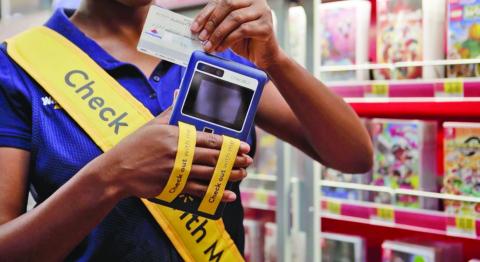
The baskets could get even bigger as the service evolves to delivery from grocery pickup and shoppers gain the ability to choose from a rapidly expanding assortment of general merchandise. “Walmart, like most retailers, has to serve shoppers how they choose to engage. That’s why it’s building an omnichannel ecosystem of fulfillment methods,” Troy says, pointing to the company’s delivery pilots. “If it works, the service could be expanded as rapidly as Walmart added grocery pickup.”
Walmart has impressed market analysts as well.
“Walmart’s efforts haven’t just halted Amazon’s impact on its biggest business — they’ve attracted new customers to the retailer that spend more per trip than in-store grocery shoppers,” stock advisor Adam Levy wrote for The Motley Fool this past June. “Amazon has made several moves to integrate Prime and Whole Foods to offer more online grocery options for its customers.”

Amazon Prime members can pick up online orders from Whole Foods in 30 markets; Amazon also offers those customers free delivery, while Walmart charges $9.95 per delivery. But as Levy noted: “Walmart, however, has been able to leverage its vast footprint of brick-and-mortar stores to enable customers to make pickup orders at about 2,450 stores, and order delivery from over 1,000 stores. By the end of the year, Walmart will offer grocery pickup for about 80% of the U.S. population, and it’ll deliver to about 50% of households. That makes Walmart a more attractive option for most consumers in the country.”
Upping the Experience
Ward says that new, “really unique pieces of technology” will help further streamline the click-and-collect experience, among them check-in capability.
“When you’re on your way to get your grocery pickup, we allow our customers to check in and say, ‘Hey, we’re on our way.’ That sends a notification to the store and allows the store to pull the orders together, get the fresh and frozen items out right at the last minute so we maintain really high quality,” he notes. “Each of our spaces is numbered out in the parking lot. When customers pull in and they’re checked in, they can say, ‘Hey, I'm in spot No. 6.’ The associate can bring their order straight out to that car and they can get on their way in a couple of minutes. We’re seeing that prove really popular.”
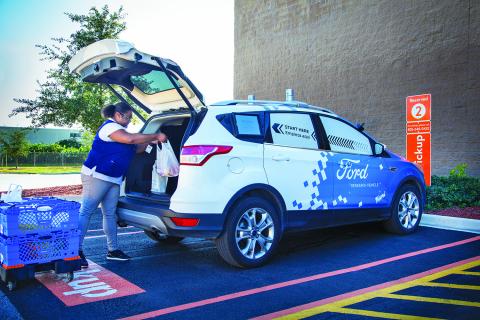
Maintaining quality within the cold chain is something that the Walmart team continues to refine. In fact, Ward believes that delivery offers shoppers a step up in food integrity. “When you’re a customer walking in and you hit the ice cream aisle and you hit the fresh meat aisle, you put those things in your cart, and then you go around, you do the rest of your shopping, and then you go through the checkouts and you load your car and you drive home. Those items that have been kept in the cart for however long, you take, 20, 30, 40 minutes,” he says. “With delivery, we keep all of our fresh and frozen orders in the fridge and freezer right until the last minute. So all the great technology that teams have built for pickup applies to our delivery business as well.
Tech Innovation
“They check in through the application automatically, and then as the driver pulls in to pick the order up, the team will consolidate those fresh and frozen areas. About 20 minutes is our average delivery time right now, so from the moment it leaves the freezer to the moment it gets to somebody’s front door, that’s about 20 minutes on average, so it’s actually a really, really good way to maintain high quality.”
Walmart considers delivery just an extension of its pickup service. “We always say delivery’s built on a pickup engine,” Ward says. “We have 2,800-plus stores running pickup right now -- obviously, we’re opening those at a pretty aggressive rate. The muscle inside the store picks multiple orders at once. So the personal shoppers that we have that’s out there on the sales floor, they’re picking up to eight different orders at a time to maximize productivity. But they don’t actually know if they’re picking a delivery order or a pickup order. They’re just picking an order.
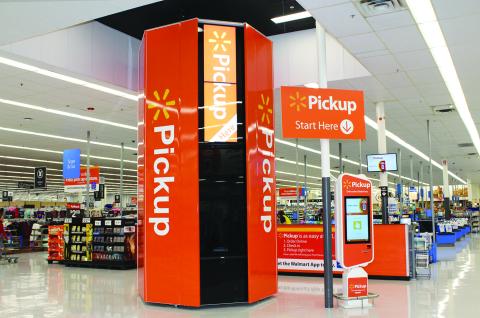
“They then stage that order in the back of house. It’s not until the driver arrives that we realize it’s a delivery or a pickup. There’s a few guidelines that our associates follow when it’s a delivery driver, but for the most part, that’s what's enabled us to scale so quickly in terms of the delivery space. It might actually get to about 50% national coverage this year, from a standing start only about 12 or 18 months ago.”
The next step – autonomous delivery vehicles – is in the pilot stage and is expected to further drive cost out of the process.
“We’re really excited about this space. We’ve been looking into it for a long time,” Ward says. “There’s two primary things that are exciting in this space: There’s helping take cost out of the delivery model by using an autonomous vehicle. It could take a grocery order from the store all the way to the customer’s house. That helps us reinvest back into prices and reinforce that key factor for our customers, saving money, plus time with the convenience and the delivery.”
.jpg?itok=MMJMF1_F)
Testing is under way in Arizona – a partnership with Burlingame, Calif.-based technology company Udelv and its second-generation autonomous delivery van, the Newton – where the technology is already making waves. “This thing turns up and customers are excited to go out there and retrieve their order,” Ward says. “It has a compartmentalization system, so the vehicle can actually hold multiple orders and just reveal the customer’s order that it arrives at. We’re excited to see what we can do with these.”
Another test, in the area around Walmart’s headquarters, with Palo Alto, Calif.-based autonomous-vehicle company Gatik, was announced in June. “That’s a slightly different use case. That’s where we take volume that we pick for our online customers from one facility, and we actually move it to a different facility so the customers can get all the convenience of pickup, even if the store itself doesn’t pick the orders,” Ward explains.

“Autonomous vehicles play a big role in that, because we operate that hub-and-spoke system really successfully in a number of markets, including Bentonville, but we use a gas-powered, person-driven truck right now. We’ll pick the orders in one place, we’ll put them into the truck, and we’ll transport them to the spoke. What Gatik is helping us do is make that spoke journey with an autonomous vehicle. It’s really exciting to see where that was going to go next. We think we can take a lot of cost out and pass that back on to the network.”
Next on the list is voice ordering, which Ward expects “to be really big, and that’s why we went in hard with the partnerships we announced earlier this year.”
‘DOING WHAT IS RIGHT’
Heaping huge praise on Walmart overall, and McMillon in particular, is Burt Flickinger, managing director of New York-based consumer industry consultancy Strategic Resource Group.
As what Flickinger calls the “Retail Ice Age” approaches for 20th-century legacy retailers, including department and specialty stores and grocery and drug retailers, the retailers best positioned to win “have the best leaders who invest in innovation to lower prices to raise shoppers’ standards of living.”
For Flickinger, Walmart leads the winners list, scoring points for leadership, innovation, sustainability, and commitment to lower costs and prices. “Walmart has younger, dynamic transformational leadership” in McMillon, “the last of the handpicked young leaders chosen by Mr. Sam [Walton, founder of Walmart],” the longtime grocery industry observer says.
Flickinger calls McMillon “a humble, dynamic leader,” as well as the first to successfully change the company from a family-controlled and -managed business to “a professionally led company focusing on raising shoppers’ standard of living worldwide, through lower prices with good quality, and profitably increasing sales growth for Walmart and its suppliers.”
He continues: “Doug McMillon consistently works with dedication combined with great determination and effectiveness … based on his strong personal and professional beliefs in what he reinforces to do what is right.”
This includes raising wages and benefits, leading other mass retailers to follow suit, increasing store staffing and service, strong community and consumer commitments, hiring veterans and disabled workers, and accelerating leadership in solar and sustainable energy.
Flickinger places great weight on this last initiative, citing research that shows a growing number of consumers plan to switch their shopping dollars to retailers dedicated to sustainable energy.
“In the retail ‘War of the Worlds’ versus Amazon, Doug McMillon has worked exceptionally with [Walmart Ecommerce U.S. President and CEO] Marc Lore on Walmart.com to ‘checkmate’ Amazon and have Walmart.com deliveries available to 90% of the U.S. population within the next year,” Flickinger says.
With strong financial returns, Walmart is “brilliantly reinvesting those savings into the best advertising, marketing and merchandising, as well as higher wages and levels of store staffing and shopper service,” he asserts.
“While most of food, drug, and department and specialty store retail chains are getting crushed with higher costs, Walmart is very entrepreneurial and innovative in every important area for consumers, from solar power and sustainable energy to sourcing goods and services locally as much as possible,” Flickinger continues. “Walmart is winning by ‘doing what is right,’ realizing record market shares and shopper satisfaction scores.”
The service aims to leverage the proliferation of in-home voice-assist devices among consumers, although Ward admits that shopping this way “hasn’t really taken off that broadly” – yet.
“We think the reason it’s pretty hard to shop through a device on voice [is] because you need to see the item that you’re looking for. So what we did with our online grocery project is, when customers sign up for Google Home, we already know what it is that they buy. … Rather than having a conversation with the voice unit … it asks you the one we’re pretty sure you want, from the first time. We’ve seen this has been a true time-saving convenience play. It’s less about doing shopping, because cell phones and laptops and so on are perfectly designed for those kinds of occasions.
“This is more about when you’re in the kitchen and you realize you’ve run out of something — hands are full and the kids are playing — you can say, ‘OK, Google, talk to Walmart, add Pepsi,’ and it will add it to your cart. We’re really excited about what we’re seeing in this space, and we think that it’s the right balance of convenience and technology that suits customers’ needs right now.”
Removing Friction
Yet with all of the technology innovations aimed at making it easier for folks to shop from home, Walmart remains committed to its stores, announcing an extensive capital expenditures program earlier this year.
“I think the store is absolutely critical to the omnichannel experience,” Ward says. “Physical traffic continues to grow. The biggest areas customers tell us they want us to invest in are our fresh areas, where you can see considerable reinvention.”
Enhanced fresh areas, including produce and prepared foods, were indeed in evidence during PG’s visit to Walmart’s flagship store in Rogers, Ark., near its corporate headquarters. The store is a test site for many new initiatives.
“We see that translate online through the omnichannel,” Ward says. “We have a really high fresh penetration in our baskets. That’s across the board, from produce to meat and seafood to bakery. And then the checkout experience – we continue to transform our front end. We go through constant iterations of, how do we continue to take more and more friction out of that area for customers?
“That means they can walk into the store, they can find what they’re looking for really easily. They can use tools within our app, like Item Finder and maps that allow them to navigate their shopping route really efficiently. When they find the items they want, they just want to go to the checkout and get out.”
Meanwhile, Walmart continues to aggressively expand pickup and delivery, with about 3,200 stores expected to be activated with online grocery by year’s end.
“I think we get to about 78% of all U.S. households covered by My Grocery Pickup by the end of this year, and 50% delivery, around 1,400 stores for that,” Ward notes. “We’re really excited about the scale that we’re going to be able to reach and the access that that’s going to provide to customers.”
Walmart’s tech incubator is helping feed all of these initiatives. ”Within my organization, we have a lab down here on 8th Street [in Bentonville] where we test all kinds of technology,” Ward explains. “Anywhere we can take cost out of our business or drive efficiency, that means we can pass that back onto the business and allow it to invest in price, and more convenience through the remodels and the capital program.”
The lab tests everything from autonomous vehicles, to autonomous picking cars that are piloted tested at a number of locations right now, “to the less flashy stuff that’s even more exciting,” Ward says, such as the algorithms that allow stores to pick orders more efficiently and, for example, make better substitution choices.
“Once we learn that about our customers, we can make much more seamless decisions that help them just get on with their day and put more trust into the online grocery business, which is all driven through the experimentation and testing that we do within the teams,” he says.
Being a Positive Force
Walmart’s ability to thrive in the future, McMillon said last June, “comes down to one thing: our ability to solve problems together well enough and fast enough.”
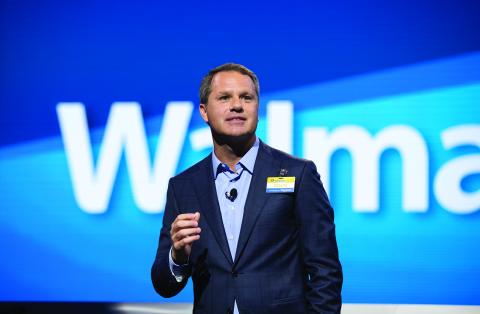
That extends beyond shopper-focused initiatives. For store associates, the retailer is introducing new apps, new hardware, and new forms of automation like pickup towers and floor cleaners, with cameras checking inventory. “Our goal is to design tools for associates just as well as we design experiences for customers,” McMillon said, “and we want our associates to grow and be ready to use them.”
PG got a peek at a few of these innovations at the Rogers flagship store, where a robot plied the aisles scanning for out-of-stocks, shoppers accessed orders via touchscreen from a pickup tower, and a new online order rack system stood poised to come online, to expedite click-and-collect orders.
Walmart’s also investing in its associates, rolling out an incremental $4.5 billion in pay for store and club associates in the United States, boosting its starting wage rate by 50 percent, and increasing the number of full-time roles to 60% full-time in the United States, ahead of the industry average, McMillon noted.

Further, the retailer expanded its parental leave policy to 16 weeks and created a benefit of $5,000 per child to help families that are growing through adoption. Also this year, the company expanded Live Better U, its debt-free, dollar-a-day college program, by adding technology degrees and more schools, and support for high school students entering the workforce. “As technology changes jobs, and the tasks that make up a job, we want our associates to learn and succeed,” McMillon said.
On the sustainability front, Walmart is two years into Project Gigaton, which aims to avoid 1 billion metric tons of emissions from its supply chain. To date, the company has signed on more than 1,000 of its supplier partners to the program. “In the first two years, they tell us more than 93 million metric tons of emissions have been avoided,” McMillon said.
Additionally, Walmart reports that it’s now powered by 28% renewable energy, diverts 78% of its waste from landfills, has hired more than 225,000 U.S. veterans since 2013, is a top 50 Diversity Inc company, donated $1.4 billion in cash and in-kind gifts last year, and has provided 4 billion meals to those in need since 2014.
A Simple Mission

What’s a typical day for the Walmart team?
Not surprisingly, Ward indicates that there’s really no such thing.
“I spend the beginning part of the day looking over what all we’ve got to do that day, basically, reviewing all the numbers from the days before, and any opportunities that we think we might have. We always tie up with our operations teams,” he recounts. “We have a really fantastic group out in the field that are delivering this work. I’m always interested to hear what their views are, because programs roll out from the home office, and we hope they land one way, and the field team tells me if they don’t. So I constantly think about how we can improve.
“We have a really grounded presence in the stores, because that’s where our personal shoppers work every day, and our regional ecommerce teams. But equally, we have people working on improvements that are based out in our offices in Bangalore [India] and San Francisco. … There’s probably no typical day. There’s just a day where we understand things, fix things and get excited about new things.”
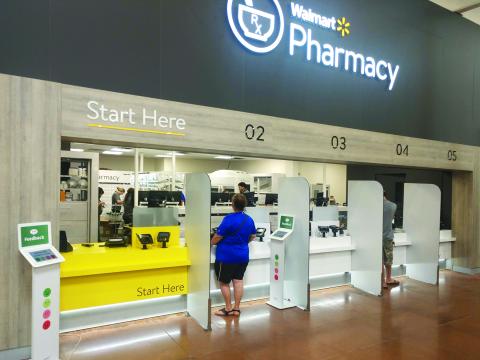
What makes Walmart such a great place to work for those aiming to change the course of grocery retail?
The scale and the opportunity, Ward says: “We have an excellent mission at Walmart, and it’s the easiest mission to remember: Just save money, live better. I think increasingly, saving people time goes hand in hand with living better. If you have that as your north star, and with the resource and the footprint that Walmart has, and once we built some momentum and trust within the business, there’s not many things that people tell me I can’t do as long as we get a great result out of it. That really motivates the team.
“There’s not many places that you can get the kind of opportunity you can get here at Walmart to change as many lives. Realistically, we’ve done everything we’ve set out to do, but we continue to stretch the limitations of what’s possible for our customers. It motivates the team all the way through, from the ground up.”





